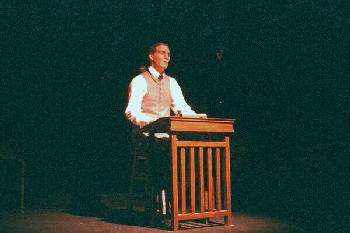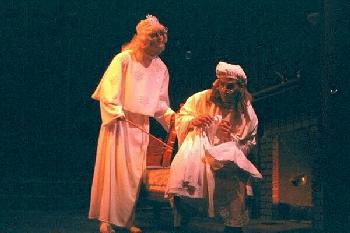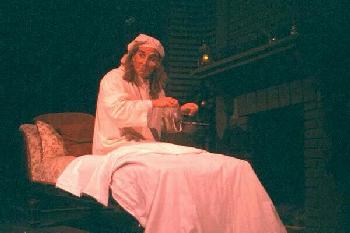A Christmas Carol
Ferndale Repertory Theatre, Ferndale CA

Director: Patrick Spike
Set by Tom Roscoe
Lights by Joe Collins
Costumes by Denise Ryles-Romei
Props by Willie Welton
Set by Tom Roscoe
Lights by Joe Collins
Costumes by Denise Ryles-Romei
Props by Willie Welton
These photos are the property of Patrick Spike, please do not duplicate, download, copy or print without expressed permission. Thank you.
Concept Statement, A Christmas Carol (Michael Paller adaptation)
Introduction
When hired to direct this production of A Christmas Carol I was pleased at the choice of script. I had previously choreographed the 2 dances for a different production of this same adaptation so I was familiar with it. The Michael Paller script expands the scope of the story's themes. In addition to the classic Dickens’ themes, Paller also weaves in the issues of creativity and creative possibilities in the characters of the family. My hope was to present not just another production of A Christmas Carol, the world’s most produced story, but to create something fresh and new that would capture our hearts and minds in a whole new way while still satisfying the Dickens enthusiasts.
Concept & Goals (as distributed at the first production meeting)
Vision Statement
This production will explore the relationship of creativity, and open heart to our ‘real’ lives. We all must be willing to open ourselves to possibilities, to step out of a comfort zone in order to achieve something real, something of human value.
Journey Statement - dramatic experience for the spectator
We follow Dickens as both himself, and as himself playing Scrooge. Beginning with his contact with The Child, his antagonist, we see a man caught in a stagnant level of emotional attachment. His creative spark is dying. He is unwilling to take risks. Once the creative seed is planted by that inner child, he begins to explore the darker side of himself and what he might become (Scrooge) and the fact that this character needs to open himself to the world, to take the risk of emotional connection, to stop hiding. As Dickens lives and explores through the character of Scrooge, his own creativity is enlivened and he is renewed to explore the world again.
Audience Journey: The members of the audience are first exposed to Dickens in his dark and isolated attic room alone, writing his autobiography, looking back on the past with bitterness, darkness. He struggles with his inner child, arguing and stuck. As the exploration of a new story comes to life through the collective imaginations of Dickens and his family and friends, he learns that no one can live in isolation, that he must open himself to the world around him and look to the future, rather than the past. As the audience follows him to the conclusion, he not only understands the journey that Scrooge has made, but understands that that journey is a product of his own imagination in combination with the other participants. That only through an openness, a willingness to collaborate and take risks can he truly be alive. Through this process, the audience should attach themselves to Dickens as well as his band of players, finding in them a representation of humanity as a whole. They could choose the darker side of life, but instead they are exposed to the positive, the alive, the openness that only comes through the risk of emotional connection.
Style
Overall quality: This production should appear as a glimpse into our often thought of as ‘quaint’ past. It might vary between the fixed feel of an antique etching to the rich and intangible feel of a stylish and memorable dream.
Stage world: This is a world where reality and creative imagination begin as distinct, but progress and merge into something that is richer than either alone. The final reality is uplifted by the collective imaginations of its inhabitants.
Cast: (See pages 4 and 5 of script)
Concept Metaphor: You carefully open the bottom drawer of an empty, dusty, weathered, antique dresser. You pull out the drawer and reach far inside the cabinet to find an ancient sepia toned photograph of unknown origin. It is dusty, cracked, wrinkled from being pressed behind the old drawer. As you move it into the warmth of light it suddenly opens, smoothes, and blossoms into rich and vibrant colors. It is new again.
Design: The script and this concept require an ability to move from the isolated confines of Dickens' cramped attic into the expansive world of the players collective imaginations - we are no longer in a reality, but rather a limitless world of possibilities. The hard reality of the attic must appear to dissolve away. We are whisked from place to place, realm to realm.
Script
Samuel French, Inc. No deletions or alterations anticipated.
Challenges and Approach
Our biggest challenge within this script was bringing to the unfolding and opening up of the set a magical quality that symbolized the opening of the characters' collective imaginations. The idea was that the single room attic expaned into various locations as the story came to life. To accomplish this required a kinetic set as well as elaborate and intricate lighting. The set was designed beautifully with various 2 dimensional backdrops done in a black and white etching style, rotating and sliding pieces to make the back of the attic room disappear and to make the space take on various looks. The drawback to this set was the need for numerous crew members to make it all operate in unison. Additionally, the theatre had not yet acquired its current computerized lighting system. Therefore 2 different systems were utilized as well as a large number of ‘hot-patches’ backstage to allow for more looks, requiring 2 board operators attempting to synchronize efforts.
Ultimately we ended up with a crew that outnumbered the cast, made up largely of young people with little or no theatre experience.
Outcome
I was largely disappointed in the final product in that the technical aspects and lack of competent crew seemed to bring our momentum to a screeching halt. While rehearsals with the cast in the rehearsal space had be highly creative, collaborative and successful, the addition of the technical elements caused havoc. Due to the Christmas season as well as the volunteer nature of the organization, we had a great deal of trouble finding willing crew members to join the project and ended up, quite frankly, with primarily incapable people. Our stage manager was irresponsible and inexperienced. Our costumer/assistant stage manager was equally irresponsible, arriving consistently late or not at all. Other crew members were hot-headed teenagers or simply incapable of doing their jobs adequately. This led to enormous frustration for myself, the technical director, the artistic director and the cast. The show’s rhythms were flattened and the pace delayed due to technical errors. What started out as an incredibly exciting and collaborative production became a technical nightmare.
Luckily, audiences seemed to truly enjoy the production and most of the trouble with the technical end was not apparent to the audience.
I’m proud of my direction of the production and especially of my concept work. If the problems with crew members could have been avoided, I’m confident that my original vision of the production would have been more fully realized.
Introduction
When hired to direct this production of A Christmas Carol I was pleased at the choice of script. I had previously choreographed the 2 dances for a different production of this same adaptation so I was familiar with it. The Michael Paller script expands the scope of the story's themes. In addition to the classic Dickens’ themes, Paller also weaves in the issues of creativity and creative possibilities in the characters of the family. My hope was to present not just another production of A Christmas Carol, the world’s most produced story, but to create something fresh and new that would capture our hearts and minds in a whole new way while still satisfying the Dickens enthusiasts.
Concept & Goals (as distributed at the first production meeting)
Vision Statement
This production will explore the relationship of creativity, and open heart to our ‘real’ lives. We all must be willing to open ourselves to possibilities, to step out of a comfort zone in order to achieve something real, something of human value.
Journey Statement - dramatic experience for the spectator
We follow Dickens as both himself, and as himself playing Scrooge. Beginning with his contact with The Child, his antagonist, we see a man caught in a stagnant level of emotional attachment. His creative spark is dying. He is unwilling to take risks. Once the creative seed is planted by that inner child, he begins to explore the darker side of himself and what he might become (Scrooge) and the fact that this character needs to open himself to the world, to take the risk of emotional connection, to stop hiding. As Dickens lives and explores through the character of Scrooge, his own creativity is enlivened and he is renewed to explore the world again.
Audience Journey: The members of the audience are first exposed to Dickens in his dark and isolated attic room alone, writing his autobiography, looking back on the past with bitterness, darkness. He struggles with his inner child, arguing and stuck. As the exploration of a new story comes to life through the collective imaginations of Dickens and his family and friends, he learns that no one can live in isolation, that he must open himself to the world around him and look to the future, rather than the past. As the audience follows him to the conclusion, he not only understands the journey that Scrooge has made, but understands that that journey is a product of his own imagination in combination with the other participants. That only through an openness, a willingness to collaborate and take risks can he truly be alive. Through this process, the audience should attach themselves to Dickens as well as his band of players, finding in them a representation of humanity as a whole. They could choose the darker side of life, but instead they are exposed to the positive, the alive, the openness that only comes through the risk of emotional connection.
Style
Overall quality: This production should appear as a glimpse into our often thought of as ‘quaint’ past. It might vary between the fixed feel of an antique etching to the rich and intangible feel of a stylish and memorable dream.
Stage world: This is a world where reality and creative imagination begin as distinct, but progress and merge into something that is richer than either alone. The final reality is uplifted by the collective imaginations of its inhabitants.
Cast: (See pages 4 and 5 of script)
Concept Metaphor: You carefully open the bottom drawer of an empty, dusty, weathered, antique dresser. You pull out the drawer and reach far inside the cabinet to find an ancient sepia toned photograph of unknown origin. It is dusty, cracked, wrinkled from being pressed behind the old drawer. As you move it into the warmth of light it suddenly opens, smoothes, and blossoms into rich and vibrant colors. It is new again.
Design: The script and this concept require an ability to move from the isolated confines of Dickens' cramped attic into the expansive world of the players collective imaginations - we are no longer in a reality, but rather a limitless world of possibilities. The hard reality of the attic must appear to dissolve away. We are whisked from place to place, realm to realm.
Script
Samuel French, Inc. No deletions or alterations anticipated.
Challenges and Approach
Our biggest challenge within this script was bringing to the unfolding and opening up of the set a magical quality that symbolized the opening of the characters' collective imaginations. The idea was that the single room attic expaned into various locations as the story came to life. To accomplish this required a kinetic set as well as elaborate and intricate lighting. The set was designed beautifully with various 2 dimensional backdrops done in a black and white etching style, rotating and sliding pieces to make the back of the attic room disappear and to make the space take on various looks. The drawback to this set was the need for numerous crew members to make it all operate in unison. Additionally, the theatre had not yet acquired its current computerized lighting system. Therefore 2 different systems were utilized as well as a large number of ‘hot-patches’ backstage to allow for more looks, requiring 2 board operators attempting to synchronize efforts.
Ultimately we ended up with a crew that outnumbered the cast, made up largely of young people with little or no theatre experience.
Outcome
I was largely disappointed in the final product in that the technical aspects and lack of competent crew seemed to bring our momentum to a screeching halt. While rehearsals with the cast in the rehearsal space had be highly creative, collaborative and successful, the addition of the technical elements caused havoc. Due to the Christmas season as well as the volunteer nature of the organization, we had a great deal of trouble finding willing crew members to join the project and ended up, quite frankly, with primarily incapable people. Our stage manager was irresponsible and inexperienced. Our costumer/assistant stage manager was equally irresponsible, arriving consistently late or not at all. Other crew members were hot-headed teenagers or simply incapable of doing their jobs adequately. This led to enormous frustration for myself, the technical director, the artistic director and the cast. The show’s rhythms were flattened and the pace delayed due to technical errors. What started out as an incredibly exciting and collaborative production became a technical nightmare.
Luckily, audiences seemed to truly enjoy the production and most of the trouble with the technical end was not apparent to the audience.
I’m proud of my direction of the production and especially of my concept work. If the problems with crew members could have been avoided, I’m confident that my original vision of the production would have been more fully realized.










